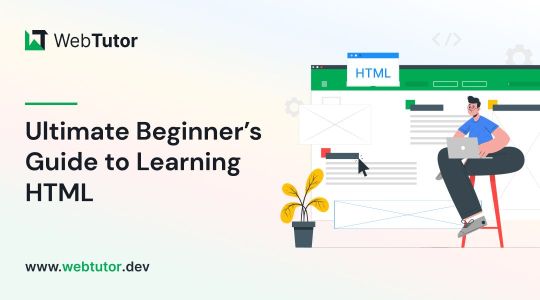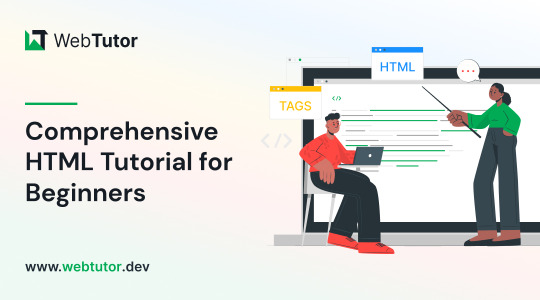#online coding courses for beginners
Explore tagged Tumblr posts
Text
Online Coding for Teachers & Students: A New Era of Learning
Online coding is revolutionizing the way both teachers and students approach learning. Online coding for teachers offers new methods to engage students, making programming more accessible and enjoyable. This digital shift allows educators to integrate coding seamlessly into lessons, providing students with essential skills for the future. Embrace the power of online coding to transform the classroom and unlock a world of learning opportunities.

#coding for kids#online coding#online coding courses for beginners#coding classes for kids#thecodelab#Online Coding for Teachers#coding programs for school#Coding for Student
0 notes
Text
HTML 101: The Ultimate Beginner's Guide to Writing, Learning & Using HTML

HTML serves as the backbone of every web page, allowing us to structure content with paragraphs, headings, images, links, forms, and more. If you're eager to delve into web development or explore the world of coding, mastering HTML is a fantastic starting point.
Join us on webtutor.dev as we unveil the ultimate guide to HTML for beginners. In this comprehensive tutorial, we'll demystify HTML, explore its diverse applications, and equip you with the skills to write your own HTML code. From essential elements to crucial attributes, we'll cover it all.
Get ready to embark on your HTML journey with webtutor.dev – your go-to resource for empowering web development education. Let us dive in and unlock the potential of HTML together.
Join us now on webtutor.dev!
What is HTML?
First published by Tim Berners-Lee in 1989, HTML is now used by 94% of all websites, and probably all the ones you visit. But what is it, exactly?
HTML, short for HyperText Markup Language, is the backbone of the web. It is a markup language that structures the content of web pages. HTML utilizes tags to define the elements and their attributes, such as headings, paragraphs, images, links, lists, forms, and more. These tags instruct web browsers on how to display and render the content to users. With HTML, developers can create interactive and visually appealing web pages. It plays a vital role in creating a seamless browsing experience by allowing users to navigate through hyperlinks and access information across different websites. HTML is the foundation upon which websites are built, providing the structure and organization for displaying text, multimedia, and interactive elements. By learning HTML, individuals can gain the skills to create and customize web pages, making their mark in the digital landscape.
Is HTML a programming language?
No, HTML (Hypertext Markup Language) is not considered a programming language. It is a markup language used for structuring the content and presenting information on web pages. HTML provides a set of tags that define the structure and semantics of the content, such as headings, paragraphs, links, images, and more.
While HTML is essential for web development, it primarily focuses on the presentation and organization of data rather than the logic and functionality found in programming languages. To add interactivity and dynamic behavior to web pages, programming languages like JavaScript are commonly used in conjunction with HTML.
What is HTML Used for?
HTML (Hypertext Markup Language) is used for creating and structuring the content of web pages. It provides a set of tags that define the elements and their layout within a web page. Here are some of the key uses of HTML:
Web page structure: HTML is used to define the structure of a web page, including headings, paragraphs, lists, tables, forms, and other elements. It allows you to organize and present content in a hierarchical manner.
Text formatting: HTML provides tags for formatting text, such as bold, italic, underline, headings of different levels, and more. These tags help in emphasizing and styling specific parts of the content.
HTML Hyperlinks: HTML enables the creation of hyperlinks, allowing you to connect different web pages together or link to external resources. Links are defined using the <a> tag and provide navigation within a website or to other websites.
Images and media: HTML allows you to embed images, videos, audio files, and other media elements into web pages. It provides tags like <img>, <video>, and <audio> for adding visual and multimedia content.
Forms and user input: HTML provides form elements, such as text fields, checkboxes, radio buttons, dropdown menus, and buttons, allowing users to enter and submit data. Form data can be processed using server-side technologies.
Semantic markup: HTML includes semantic elements that provide meaning and structure to the content. Examples of semantic elements are <header>, <nav>, <article>, <section>, <footer>, which help define the purpose and role of specific parts of a web page.
Accessibility: HTML supports accessibility features, such as providing alternative text for images, using proper heading structure, using semantic elements, and other attributes that make web content more accessible to users with disabilities.
Overall, HTML serves as the foundation of web development, providing the structure and presentation of content on the World Wide Web. It is often complemented by other technologies like CSS (Cascading Style Sheets) for styling and JavaScript for interactivity and dynamic behavior.
How to Write HTML?
<!DOCTYPE html><html><head><title>My Page</title></head><body><h1>Hello, World!</h1></body></html>
Explanation:
<!DOCTYPE html>: Specifies the HTML version.
<html>: Opening tag for the HTML document.
<head>: Contains metadata about the page.
<title>: Sets the title of the page displayed in the browser's title bar or tab.
<body>: Contains the visible content of the page.
<h1>: Defines a heading level 1.
Hello, World!: The actual content to be displayed.
Please note that this example is a very basic HTML structure, and for more complex pages, additional tags and attributes would be required.
How to Create an HTML File
To create an HTML file, you can follow these steps:
Open a text editor: Open a text editor of your choice, such as Notepad (Windows), TextEdit (Mac), Sublime Text, Visual Studio Code, or any other editor that allows you to create plain text files.
Start with the HTML doctype: At the beginning of your file, add the HTML doctype declaration, which tells the browser that the file is an HTML document. Use the following line:
<!DOCTYPE html>
Create the HTML structure: After the doctype declaration, add the opening and closing <html> tags to enclose the entire HTML document.
Add the head section: Inside the <html> tags, include the <head> section. This is where you define metadata and include any external resources like stylesheets or scripts. For now, let's add a <title> element to set the title of your page:
<head>
<title>My First HTML Page</title>
</head>
Create the body: Within the <html> tags, include the <body> section. This is where you place the visible content of your web page. You can add various HTML tags here to structure and format your content. For example, let's add a heading and a paragraph:
<body>
<h1>Welcome to My Page</h1>
<p>This is my first HTML file.</p>
</body>
Save the file: Save the file with an .html extension, such as myfile.html. Choose a suitable location on your computer to save the file.
Open the HTML file in a browser: Double-click on the HTML file you just saved. It will open in your default web browser, and you will see the content displayed according to the HTML tags you added.
Congratulations! You have created an HTML file. You can now edit the file in your text editor, add more HTML elements, styles, scripts, and save the changes to see them reflected in the browser.
Common HTML Attributes
<input type="text" name="username" placeholder="Enter your username" required>
<img src="image.jpg" alt="Image description">
<a href="https://example.com" target="_blank">Link to Example</a>
<div id="container" class="box">
<button onclick="myFunction()">Click me</button>
<table border="1">
<form action="submit.php" method="POST">
<select name="color">
<option value="red">Red</option>
<option value="blue">Blue</option>
</select>
Explanation:
<input>: Attributes like type define the input type (text, checkbox, etc.), name sets the input's name for form submission, placeholder provides a hint to the user, and required specifies that the input is mandatory.
<img>: src specifies the image source URL, and alt provides alternative text for the image (useful for accessibility).
<a>: href sets the hyperlink URL, and target="_blank" opens the link in a new tab or window.
<div>: id assigns an identifier to the element, and class adds a CSS class for styling or JavaScript targeting.
<button>: onclick triggers a JavaScript function when the button is clicked.
<table>: border adds a border to the table.
<form>: action specifies the form submission URL, and method sets the HTTP method (GET or POST).
<select>: name assigns the name for the selection input, and <option> defines the selectable options within the dropdown menu.
These are just a few examples, and there are many more HTML attributes available for different elements, each serving specific purposes.
#learn to code for free#coding course online#Online Web Tutorial#learn coding for free#online tutorial#learn code#learn code for free#introduction to coding#learn html#programming training courses#best way to learn coding#how long does it take to learn coding#learn coding for beginners#best online platform for learning coding#best place to learn to code online
4 notes
·
View notes
Text
#best institute or training institute for sap course in India#best sap training in India#best sap course#best institute for sap course in india#best 3 months sap training#learn best sap coding#learn best sap programming#best sap training videos#best online course for sap#sap course for beginners#sap course near me#sap course eligibilty#sap coaching centers near me#sap software training#sap online course with certifications
2 notes
·
View notes
Text
hhhhhhhhhhhhhhhh i hate this class so much i am so, so tempted to just Stop Doing Assignments bc i don't even fucking care that i'll "fail" it
it'll be a massive waste of money but it'd be better than banging my head against a wall repeatedly while feeling like an absolute idiot for not understanding what the fuck is supposed to be going on here
#neptalks#im just bitching i'll get over it#between one professor that's so absent i can't rely on him for any help at all#and the other class where the moment i sit down to start trying to do the work only to have my brain shut down#i feel like i'm going insane#the fucking web design class just threw us into java last week or so and this teacher is awful at explaining#in that he doesn't explain like nearly anything#and his coding that he wants us to use is full of typos or missing punctuation#so the real homework experience is just fucking fixing his shit without knowing what the fuck it is you're supposed to be fixing#i hear that's just how it is in general so i'm sure i'm preaching to the choir#but also this is a beginners course and its been riddled with missing information the entire time#its frustrating as hell#the coding class is just....... i've already bitched about that#but its been a while since i've run into something that makes me feel like a huge dumbass#bc usually i can figure stuff out if i mess around a bit#but it's just not happening here#and yeah i'm sure i could message the professor - he's been v nice the few times that i have#but w this one idek man i'd just be sending him a msg like dude i don't even know where to START with this#i've tried searching things online but that's a nightmare and a half#anyways i'm giving up i'm tired and done and cranky and i hate feeling stupid
1 note
·
View note
Text
#Learn Java#Java course#Java developer#Java script#Java certification#Java ide#Java programming#Java tutor#Jms#Jdk#Java online course#Java development kit#Java developer course#Learn Java programming#Java certification course#Java coding#Java jdk#Learn Java online#Java for beginners
0 notes
Text
The Web Developer Bootcamp 2025 - Free Course
Course Content
Introduction to Web Development
Building Web Pages with HTML5 & CSS3
JavaScript Basics & Advanced Concepts
Back-End Development with Node.js
Database Management with MongoDB
Building Full-Stack Web Applications
Deploying Projects to the Web
Join Now
#Web Development#Full-Stack Development#Udemy Course#Web Developer Bootcamp#Free Web Development Course#Learn HTML & CSS#JavaScript Basics#Node.js#MongoDB#Web Development Training#Free Online Course#Build Web Applications#Back-End Development#Front-End Development#Enroll Now#Programming Course#Beginner Web Development#Web Development Certification#Learn to Code#Web Development Bootcamp 2025#Free Coding Course
0 notes
Text
Top Free Websites to Learn Coding: Become a Developer Without Spending a Dime
Learning to code has never been more accessible, and the best part? You can do it for free! Whether you’re dreaming of building websites, apps, or diving into data science, coding is a skill that opens countless doors. But where do you start? With so many resources out there, it can be overwhelming to choose the right platform. Don’t worry; I’ve got you covered. In this post, we’re diving into…
#beginner coding resources.#best free coding websites#Codecademy courses#coding for beginners#coding skills free#free coding platforms#free coding tutorials#freeCodeCamp coding#full-stack development free courses#learn programming online free#learn to code for free
1 note
·
View note
Text
HARVARD UNIVERSITY OFFERS FREE ONLINE PYTHON COURSE: ENROLL NOW!
#learn coding with Harvard's CS50 series#Harvard University free Python programming course#learn Python programming with Harvard University#beginner-friendly Python course from Harvard University#CS50’s Introduction to Programming with Python#free online programming course by Harvard University
1 note
·
View note
Text
Be A Developer get your dream job with us guaranteed
Accelerate your career in coding. We guarantee your dream job with our comprehensive developer program. Apply now!

0 notes
Text
How to Coding for Student Like an Expert
The Code Lab makes coding for students easy and effective. Whether you're just starting or leveling up your skills, consistent practice, problem-solving, and writing clean code are key. Understanding core programming concepts and applying them to real projects will help you think like an expert. With the right guidance, learning to code becomes an exciting journey toward a future in tech.

#CodingForStudents#LearnToCode#thecodelab#coding for kids#online coding#coding classes for kids#online coding courses for beginners#online coding programs for kids#coding programs for school
0 notes
Text
Give Teens with Code: Codeyoung's Dynamic Computer Programming Classes.

Codeyoung's engaging and informative Computer Programming Classes For Teenagers open up a world of possibilities for your teenagers. Our expert-led courses combine fun and study, providing teens with the necessary coding skills for effectively navigating the digital environment. If you want to provide your teenagers with high-quality programming education, look at Codeyoung.
1 note
·
View note
Text
#CSS#phyton#C Language#HTML#C++ Language#Learn CSS#Coding Classes#Java Script#Learn HTML#java language#Programming Language#HTML Language#CSS Language#coding for beginners#online coding courses
0 notes
Text
Comprehensive HTML Tutorial for Beginners: From Zero to Hero

Welcome to WebTutor.dev, your go-to resource for learning HTML online! In this tutorial, we'll cover the fundamentals of HTML (Hypertext Markup Language) with clear explanations and practical examples. Let's dive right in!
Lesson 1: Getting Started with HTML
HTML is the backbone of any web page. It provides the structure and content of a webpage by using tags and elements. Here's a simple example of an HTML document:
<!DOCTYPE html>
<html>
<head>
<title>My First Web Page</title>
</head>
<body>
<h1>Welcome to WebTutor.dev!</h1>
<p>This is a paragraph of text.</p>
</body>
</html>
Let's break it down:
<!DOCTYPE html>: This declaration specifies that the document is an HTML5 document.
<html>: The root element of an HTML page.
<head>: Contains meta information about the webpage, such as the title.
<title>: Sets the title displayed in the browser's title bar.
<body>: The main content of the webpage.
<h1>: A heading element, in this case, the main heading of the page.
<p>: A paragraph element containing text.
Lesson 2: Structuring Content with HTML Tags
HTML offers a wide range of tags to structure and organize content. Here are some commonly used tags:
<h1> to <h6>: Headings of different levels, with <h1> being the highest.
<p>: Paragraphs of text.
<a href="https://www.example.com">Link</a>: Creates a hyperlink to another webpage.
<img src="image.jpg" alt="Description">: Inserts an image into the webpage.
<ul> and <ol>: Unordered and ordered lists, respectively.
<li>: List items inside <ul> or <ol>.
Lesson 3: Adding Styling and Formatting
HTML alone provides the structure of a webpage, but CSS (Cascading Style Sheets) is used to add visual styling and formatting. Here's an example of applying CSS to HTML:
Example
<!DOCTYPE html>
<html>
<head>
<title>Styling Example</title>
<style>
h1 {
color: blue;
font-size: 24px;
}
p {
font-family: Arial, sans-serif;
}
</style>
</head>
<body>
<h1>Welcome to WebTutor.dev!</h1>
<p>This is a styled paragraph of text.</p>
</body>
</html>
In this example, we've added a <style> block within the <head> section. We then define CSS rules to style the <h1> and <p> elements accordingly.
Lesson 4: Building Forms with HTML
HTML forms enable user interaction on webpages. Here's an example of a simple form:
<!DOCTYPE html>
<html>
<head>
<title>Form Example</title>
</head>
<body>
<h1>Sign Up</h1>
<form>
<label for="name">Name:</label>
<input type="text" id="name" name="name" required>
<br>
<label for="email">Email:</label>
<input type="email" id="email" name="email" required>
<br>
<input type="submit" value="Submit">
</form>
</body>
</html>
In this form example, we have input fields for name and email, along with a submit button. The required attribute ensures that the user must provide information in these fields before submitting the form.
Congratulations! You've completed the introductory tutorial on HTML. By understanding these core concepts and practicing with more examples, you'll be well on your way to building impressive webpages. We encourage you to explore more topics such as advanced HTML elements, responsive design, and integrating HTML with other technologies. Visit WebTutor.dev for further tutorials, resources, and community support to enhance your HTML skills. Happy coding!
#HTML Tutorial for Beginners#learning HTML online#fundamentals of HTML#learn to code for free#coding course online#Online Web Tutorial#learn coding for free#online tutorial#learn code#learn code for free#learn online coding#best online platform for learning coding#best place to learn to code online#Learn Free HTML code#HTML introduction#Learn HTML#Free HTML Tutorial#html tutorial#free online HTML editor
0 notes
Text
#Python training institute in Uttam Nagar#Python course in Uttam Nagar#Best Python training institute in Uttam Nagar#Python programming institute in Uttam Nagar#Python certification course in Uttam Nagar#Learn Python in Uttam Nagar#Python training center in Uttam Nagar#Affordable Python course in Uttam Nagar#Python classes in Uttam Nagar#Advanced Python training in Uttam Nagar#python programming#python classes near me#coding course#python institute certification#python programming institute near me#python course fee#python course online#python course fees in Delhi#python course for beginners#python course duration
0 notes
Text
#python online training#python for beginners#python#python online course#python offline training#python games#game development#python coding
0 notes
Text
Engaging Coding Classes for Kids – Learn Programming with Alpha Coding

Introduce your child to the world of technology with Alpha Coding’s interactive coding classes for kids. Our courses are designed to make learning programming fun and accessible, using engaging projects, games, and challenges. Whether your child is a complete beginner or has some coding experience, our step-by-step curriculum helps them build essential programming skills in languages like Scratch, Python, and JavaScript. Start your child’s journey in coding today and watch them develop problem-solving abilities, creativity, and critical thinking skills – all while having fun!
Enroll today and give your child the skills to succeed in the digital world!
Website: https://alphacoding.com/
Email Us On- [email protected]
Contact- +1 647-559-2311
Address- 5000 Yonge Street, Suite 1901, Toronto, M2N 7E9
#coding classes for kids#best online coding courses#online programming courses#coding courses for beginners#learn coding online#coding programming courses#online programming courses for beginners#coding and programming for beginners
1 note
·
View note